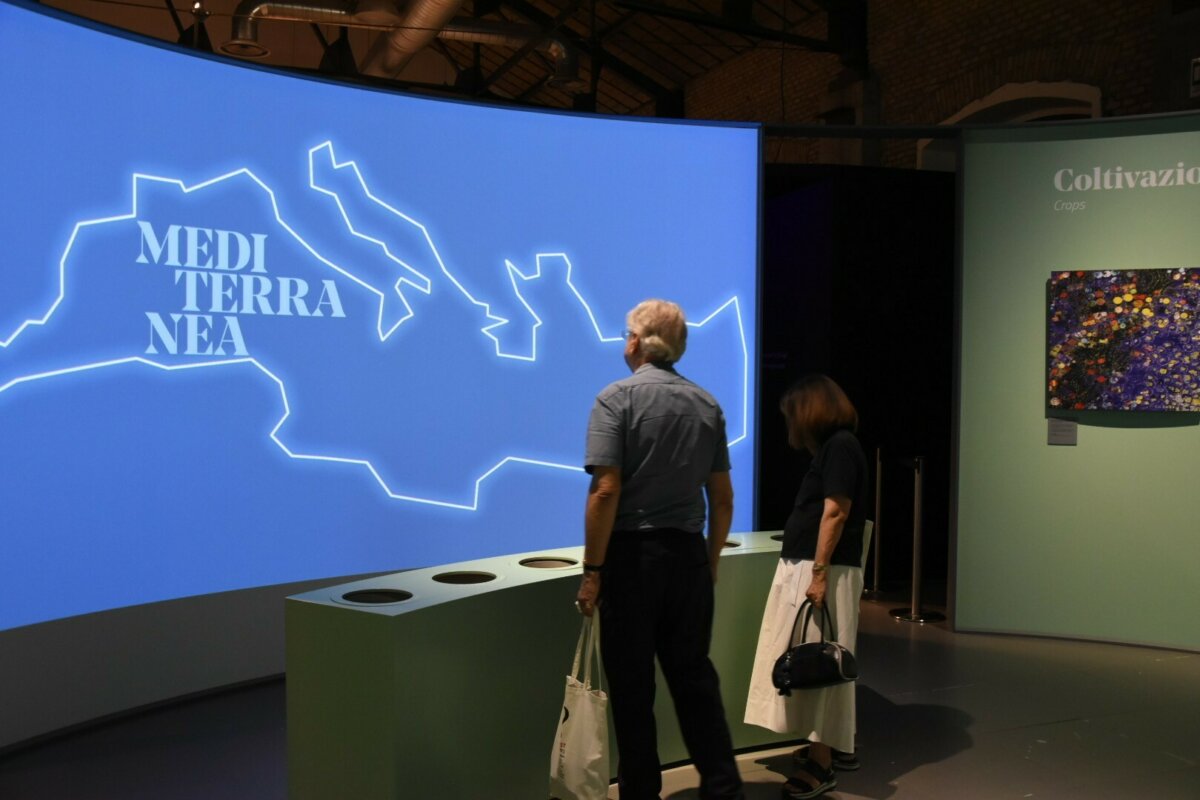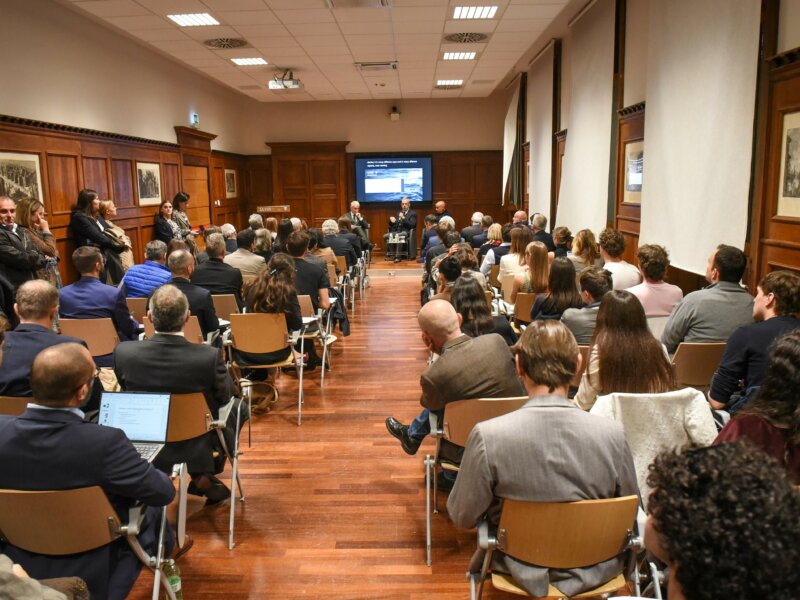The History, Present, and Future of the Global Mediterranean
The traveling exhibition “Mediterranea: Visions of an Ancient and Complex Sea” and the fifth edition of Med-Or Day, featuring the distinguished presence of Professor David Abulafia, offer an in-depth reflection not only on the historical and cultural significance of the Mediterranean but also on its renewed strategic centrality.

On 3 July 2025, the fifth edition of Med-Or Day was held in Rome, with Professor David Abulafia of Cambridge University as a distinguished guest. Entitled The History, Present, and Future of the Global Mediterranean, the event, organised by the Med-Or Italian Foundation alongside the exhibition Mediterranea: Visions of an Ancient and Complex Sea, held at MAXXI with the support of Med-Or, underscored the ever-increasing and ever-relevant importance of the “Great Sea”.
The Mediterranea Exhibition
Historia magistra vitae. How can one comprehend the complexity of the contemporary world, and the Mediterranean in particular, without first stepping back into the past? After touring prominent cities throughout the Mediterranean basin, the exhibition returned to Italy, made possible through the support of the Med-Or Italian Foundation and Fondazione MAXXI, in collaboration with the Italian Space Agency, Telespazio, e-GEOS, and the European Space Agency, and with the backing of the Ministry of Foreign Affairs and International Cooperation (MAECI) and the Ministry of Culture.
The exhibition is structured into four thematic sections that, as highlighted by the accompanying catalogue, skillfully merge art, archaeology, science, and cutting-edge technologies—including unprecedented satellite imagery and immersive installations—thus providing a high-level sensory and intellectual experience.
The first section, History of Lands and Waters, narrates the fundamental phases that have marked the history of our Great Sea via an interactive table. It begins with the earliest origins and navigates the routes of Mediterranean peoples. From the prehistoric caves of Marseille and the Egadi Islands to the earliest Phoenician settlements—transformed into vital commercial ports and hubs for the circulation of ideas such as Tyre, Syracuse, Marseille, and Athens—continuing to Roman-era relics, the Arab cities of Spain, and Ottoman dominions in the Balkans, the exhibition retraces a historical path that restores the Mediterranean as a “great emporium” of exchange and cultural intermingling. Satellite images and ancient maps intertwine with archaeological artifacts, such as a Roman ship’s prow—silent yet eloquent witnesses to a history of sea, navigation, and power. This sea, once called nostrum in antiquity, remains today the fulcrum of major economic and geopolitical dynamics uniting East and West, North and South of the globe. Italy, in particular, regards the Mediterranean not only as a historical heritage but as a strategic asset for its economy and cultural and political exchanges.
The second section, Peoples and Cultures, explores the intricate web of human and cultural relations fostered by the Mediterranean over millennia. A natural bridge among three continents, this sea witnessed the flourishing of extraordinary civilizations—from Egyptian and Cretan to Phoenician, Greek, Roman, Byzantine, Arab, and Ottoman. Each left an indelible mark upon the coasts, islands, and languages in a continuous dialogue of encounter and conflict, fusion and differentiation. The sound installation Voices of the Mediterranean conveys the experience of a plurilingual and culturally rich sea, yet one divided by misunderstandings and tensions. Myths linked to this sea—such as those of Ulysses or the Colossus of Rhodes—evoke the symbolic dimension of a body of water that is also imaginary, a crossroads of narratives and identities. Cities born along its shores—Alexandria, Istanbul, Venice, Beirut—serve simultaneously as historic centers of power and gateways to new trade routes.
The third section, Vegetation and Fragrances, introduces a perhaps lesser-known but equally significant dimension: nature and agriculture, which have shaped the Mediterranean landscape. Agriculture radically transformed this space by importing plant species from around the world which, although non-indigenous, have become integral to the region’s characteristic flora and scents. Satellite imagery evocatively reveals the geometries of cultivation, while an olfactory installation immerses visitors in a multisensory experience featuring aromas of thyme, lavender, rosemary, myrtle, and more. Particular attention is devoted to the North African coast, where human-environment interaction manifests also in battles against desertification, visible in satellite images showing pivot irrigation systems creating verdant circles in the Sahara Desert.
Finally, the fourth section, The Mediterranean Today, presents a current and complex portrait of this sea, crucial for life and global geopolitical dynamics. With a population now exceeding 500 million, 70% of whom reside in urban areas, the Mediterranean region is characterized by continuously growing coastal density and intense urbanization. Coastal cities have become nerve centers for economic, cultural, and social relations. However, this expansion brings environmental, social, and political challenges that will be decisive for the region’s future. Climate change, migration, demographic imbalances, and economic inequalities intertwine in a context requiring shared governance at both national and international levels.
In summary, the Mediterranea exhibition is not merely a display of works and artifacts; it is a complex and captivating narrative that invites reflection on the Mediterranean’s fundamental role in human history, its contemporary tensions, and its future potential. A journey through myth, memory, and current affairs, it vividly reaffirms the centrality of this “sea among lands” on the global stage, highlighting its cultural, natural, and strategic peculiarities. It is an invitation to view the Mediterranean with renewed awareness, mindful of its millennia-old history and the challenges it faces in the twenty-first century.
The Great Sea
The name Mediterranean, the “sea among lands,” is the earliest testament to its unique characteristic: it is the Liquid Continent, not merely a connection among those inhabiting its shores, but their home, the pulsating heart of life for the peoples and civilizations that have flourished around it.
In Roman times, the Mediterranean was Mare Nostrum, a symbol of Roman supremacy and the link among the Empire’s provinces. Yet even before Rome, the sea was traversed by the Phoenicians, skilled navigators and traders who connected the Levantine coasts to Carthage, then the Iberian Peninsula, and beyond the Strait of Gibraltar to the Moroccan coasts and northward to Britain. Classical Greece, with Athens at its forefront, made the Eastern Mediterranean a stage for art, politics, and philosophy, fostering a culture that remains foundational to Western civilization. Prior still, it was the arena of ancient civilizations such as the Egyptians, Mycenaeans, and Minoans. In the Middle Ages, the Italian Maritime Republics—Amalfi, Genoa, Pisa, and Venice—dominated Mediterranean routes. These city-states became not only commercial powers but also cultural and political centers. Venice, in particular, emerged as a maritime empire, creating a Stato da Mar that extended to the Aegean. Control over trade routes, spices, and textiles enriched and empowered these cities, shaping European economy and diplomacy for centuries.
Beyond serving as a cultural and commercial hub, the Mediterranean was the theatre of great conflicts and struggles for regional hegemony that defined entire epochs. From the classical rivalry between Greeks and Persians in the Eastern Mediterranean and the clash of Rome and Carthage, through the medieval period, to the modern era with the rise of the Ottoman Empire in the East. Numerous legendary naval battles marked its waters—from Salamis to the Egadi Islands, from Actium to Lepanto.
With the expansion of Atlantic routes and openings toward the Americas and the Orient between the 17th and 19th centuries, the Mediterranean experienced an apparent decline. Trade axes shifted towards the great oceans, and the inland sea progressively lost its economic and political primacy. Even during the 20th century, amid Cold War dynamics centered on transatlantic and continental interests, the Mediterranean seemed relegated to a secondary role, silently observing global transformations. Nevertheless, especially with the advent of the fossil fuel era, the routes through Suez retained great commercial and economic significance, given that many of the countries bordering its waters are among the planet’s major hydrocarbon producers.
In recent decades, however, the Mediterranean has regained a new centrality, becoming once again a focal point of global geopolitics. Tensions in North Africa, the Arab Spring, conflicts in the Middle East, and energy crises have refocused attention on the “Middle Sea.” Migration routes, new global connections via extensive submarine infrastructure, and emerging trade routes from the East and ascending Asia crossing the Mediterranean have made evident its role as a bridge between diverse worlds and a renewed strategic crossroads for the global economy.
Italy, thanks to its geographical position, proposes itself as a continental hub, a role reinforced by the recent Mattei Plan for Africa, designed to revive partnerships with African countries through development projects, cooperation, and mutual security.
Yet Italy, in this vision, no longer stands merely as a bridge between Europe and Africa but emerges as a potential protagonist in redefining economic and strategic relations in the Great Sea and with partners in the Global South. Always a bridge and a frontier, the Peninsula may once more play an active and innovative role in reshaping the balances of the world to come.
Looking to the Future
Today, the Mediterranean presents itself as a strategic crossroads of global significance, not only for Europe but for the entire international system.
Contemporary international affairs are the foremost evidence confirming this centrality. Yet history and economics also delineate the dimensions of this region’s enduring importance. Present-day challenges—from environmental to security issues—are often interconnected. The problems afflicting the sea and its lands frequently transcend borders and divisions and are shared among many countries. Nevertheless, the Mediterranean today and tomorrow, as throughout its history, remains and will remain a great crossroads of exchange, trade, and cultures, rendering it a unique global area where the Global South, between Africa and Asia, will continue to meet and engage with Europe and the West. All of this, notably through the installations of the Mediterranea exhibition, is conveyed with remarkable precision and efficacy.
Click HERE to see the video of the exhibition



